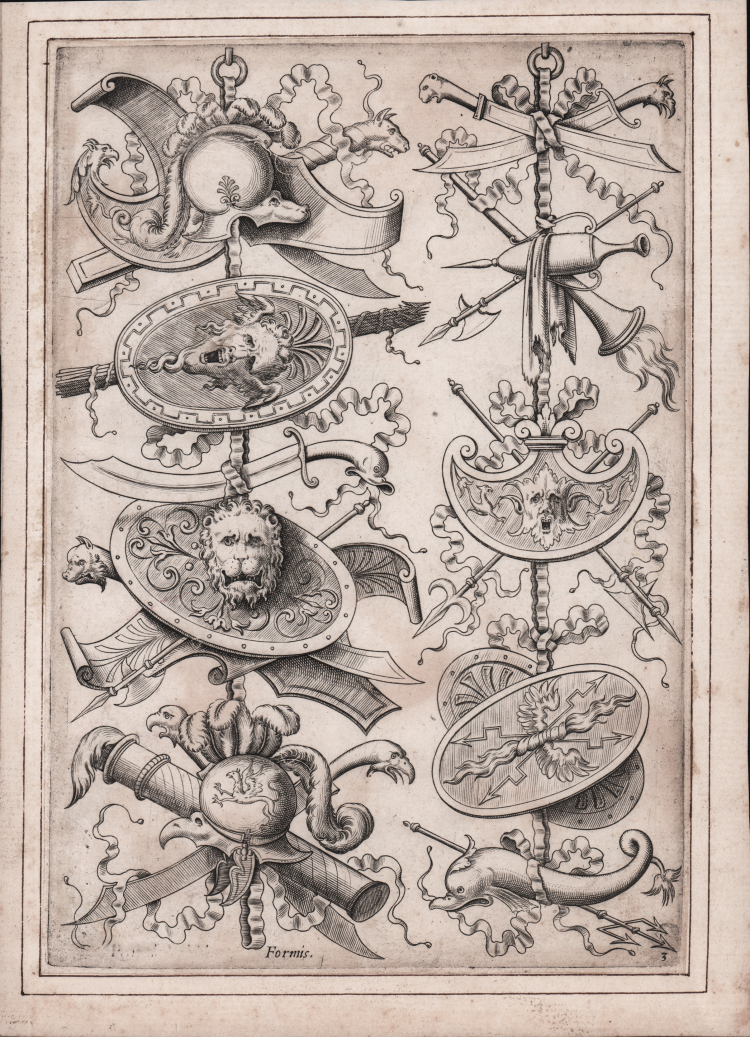




| Reference: | S28337 |
| Author | Enea VICO |
| Year: | 1550 ca. |
| Measures: | 170 x 248 mm |



| Reference: | S28337 |
| Author | Enea VICO |
| Year: | 1550 ca. |
| Measures: | 170 x 248 mm |
Engraving, about 1550.
After Polidoro da Caravaggio.
Good impression, printed on contemporary laid paper, with thin margins, laid down an antique mounting, in good condition. This work belong to a series that is listed in the index of prints by Antonio Lafrery of 1573 under the name of Libro de Trofei cavati da disegni di Polidoro ad imitazione de gli Antichi. On the death of Lafrery (1577), the plates passed to his nephew Claudio Duchetti and then to Paul Graziani and Pietro de 'Nobili. In the inventory of the latter dating back to 1584, the series turns out to be sixteen prints. However, the plates back to the period 1550/53 and are the result of the rivalry before, and then merging, printing works of Antonio Salamanca and Antonio Lafrery.
Bartsch gives the engravings to Enea Vico. Rare.
|
Bartsch 438, 442, 447; Bury, The Print in Italy, pp. 60/2, 38; Guilmard 1880/1 21.10(4); Berlin 1939 540(3); Robert-Dumesnil 1835-71 VIII.72.153.II; IFF vol. I p.196.
|
Enea VICO (Parma 1523 - Ferrara 1567)
|
Enea, son of Francesco, was antique dealer, drawer, engraver and numismatist. He was born in Parma on January 29th, 1523, according to what Huber says. After the first school years in the city, and very likely after he made acquaintance with the works of Giulio Romano, Vico moved to Rome in 1541. He then worked for Tommaso Barlacchi, who also engraved with him a series of Grottesche, in 1542. In the classical atmosphere of Rome, Vico’s style developed according to that of Perin del Vaga and Francesco Salviati, but always with Parmigianino as main reference. Around the first half of the century and after studying the works of Marcantonio, Agostino Veneziano, Caraglio and Bonasone, Vico acquired his own, peculiar style which can be seen in his main works. From Rome Vico moved to Florence, where he worked for Cosimo I, and then went to Venice, in 1557. In 1563 he is already in Ferrara, working for Alfonso d’Este till his death in 1567.
|
|
Bartsch 438, 442, 447; Bury, The Print in Italy, pp. 60/2, 38; Guilmard 1880/1 21.10(4); Berlin 1939 540(3); Robert-Dumesnil 1835-71 VIII.72.153.II; IFF vol. I p.196.
|
Enea VICO (Parma 1523 - Ferrara 1567)
|
Enea, son of Francesco, was antique dealer, drawer, engraver and numismatist. He was born in Parma on January 29th, 1523, according to what Huber says. After the first school years in the city, and very likely after he made acquaintance with the works of Giulio Romano, Vico moved to Rome in 1541. He then worked for Tommaso Barlacchi, who also engraved with him a series of Grottesche, in 1542. In the classical atmosphere of Rome, Vico’s style developed according to that of Perin del Vaga and Francesco Salviati, but always with Parmigianino as main reference. Around the first half of the century and after studying the works of Marcantonio, Agostino Veneziano, Caraglio and Bonasone, Vico acquired his own, peculiar style which can be seen in his main works. From Rome Vico moved to Florence, where he worked for Cosimo I, and then went to Venice, in 1557. In 1563 he is already in Ferrara, working for Alfonso d’Este till his death in 1567.
|